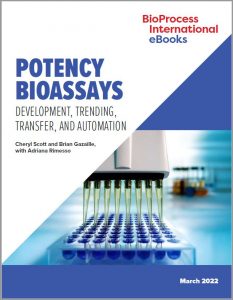 Bioassay development is a complex process that must be undertaken with great rigor and attention to detail. Potency testing experts use a range of methods including cell-based and binding assays. Consistency and reliability of results over time are paramount. Well-developed and -characterized methods are the end result of much phase-appropriate development work that goes on in parallel with bioprocess and biotherapeutic product development. This eBook begins with BPI senior technical editor Cheryl Scott’s report from the Biopharmaceutical Emerging Best Practices Association’s 2022 bioassay conference. The virtual event, held on 21–24 March 2022, featured several presentations about the obstacles associated with potency assays for gene therapies based on adenoassociated virus (AAV) vectors and for chimeric antigen receptor (CAR) T-cell therapies. Presenters also explored strategies for determining system suitability and for analyzing and trending data generated by cell-based potency assays. The eBook concludes with an in-depth discussion about bioassay development between BPI associate editor Brian Gazaille and Adriana Rimesso, an analytical development scientist at Biogen. Rimesso addresses practical concerns for developing, qualifying, and validating cell-based assays. She also highlights the value of cross-departmental collaboration, especially when transferring analytical methods across teams and sites and when evaluating bioassay accuracy and precision.
Bioassay development is a complex process that must be undertaken with great rigor and attention to detail. Potency testing experts use a range of methods including cell-based and binding assays. Consistency and reliability of results over time are paramount. Well-developed and -characterized methods are the end result of much phase-appropriate development work that goes on in parallel with bioprocess and biotherapeutic product development. This eBook begins with BPI senior technical editor Cheryl Scott’s report from the Biopharmaceutical Emerging Best Practices Association’s 2022 bioassay conference. The virtual event, held on 21–24 March 2022, featured several presentations about the obstacles associated with potency assays for gene therapies based on adenoassociated virus (AAV) vectors and for chimeric antigen receptor (CAR) T-cell therapies. Presenters also explored strategies for determining system suitability and for analyzing and trending data generated by cell-based potency assays. The eBook concludes with an in-depth discussion about bioassay development between BPI associate editor Brian Gazaille and Adriana Rimesso, an analytical development scientist at Biogen. Rimesso addresses practical concerns for developing, qualifying, and validating cell-based assays. She also highlights the value of cross-departmental collaboration, especially when transferring analytical methods across teams and sites and when evaluating bioassay accuracy and precision.
Fill out the form below to read the complete eBook now.
